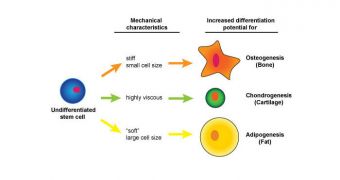Scientists at the Brown University, in the United States, say that they have recently made a significant discovery related to the mechanical properties of stem cells. After carefully analyzing these properties, the group found that the data could be used to predict the type of cell stem cells would differentiate into.
Mesenchymal stem cells, for example, are used by tissue engineers to create fat, cartilages or bones. Over the years, the experts have found that the most suitable cells for the task are those that would have developed into the desired tissue on their own.
Stem cells have the ability to develop into multiple types of cells, but all of them have a predisposition towards a certain cell type. What the team managed to do was to create a method of figuring out the preferred cell type for mesenchymal stem cells.
For this study, Brown investigators used adult stem cells derived from fat. This material can be obtained via liposuctions, the team explains, and can differentiate into fat, bone or cartilages.
By analyzing the mechanical properties of this cell population, including stiffness and viscosity, the science group was able to predict the type of tissue the mesenchymal stem cells would differentiate into.
If this type of study is implemented at a wider scale, scientists will soon become able to boost the healing power of therapies that rely on stem cells for reconstructing damaged tissue. The research was conducted by investigator Eric Darling.
The expert holds an appointment as an assistant professor of medical science in the Brown Department of Molecular Pharmacology, Physiology and Biotechnology, and with the Center for Biomedical Engineering at the university.
He was also the senior author of a new paper describing the findings, which was published in the latest issue of the esteemed journal Proceedings of the National Academy of Sciences (PNAS).
“The results are exciting because not only do the mechanical properties indicate what lineage these cells could potentially go along but also the extent of their differentiation. It tells us how good they are going to be if we differentiated them for a given tissue type,” Darling explains.
“Can we enrich the cell populations for cells that we want to use, whether they are totally undifferentiated cell types, partially differentiated, or completely differentiated?. It doesn’t matter as long as it’s targeted for the specific tissue application,” he concludes.

 14 DAY TRIAL //
14 DAY TRIAL //